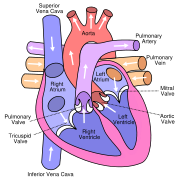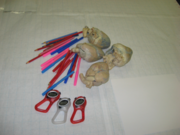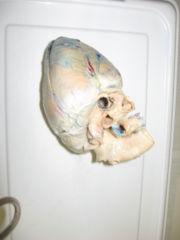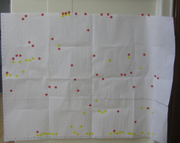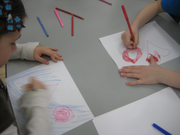Kick start your heart
| Students @ Work - a student collaborative writing project. Help us by providing feedback on the Discussion page. |
| Instant wiki maker | Making handouts | Editing tips |
Contents
- 1 Student worthiness
- 2 Primary biological content area covered
- 3 Materials
- 4 Handouts
- 5 Description of the Activity
- 6 Lesson plan
- 7 Potential pitfalls
- 8 Math connections
- 9 Literature connections
- 10 Health Connections
- 11
- 12 Connections to educational standards
- 13 Next steps
- 14 Reflections
- 15 Citations and links
- 16 Common mistakes
Biology In Elementary Schools is a Saint Michael's College student project from a course that ran between 2007 and 2010 and fully described in this book chapter. The student-created resources have been preserved here for posterity. Link under 'toolbox' for printer-friendly versions of the exercises. Click on handouts to print full resolution versions. Please see Wikieducator's disclaimer, our safety statement, and the Creative Commons licensing in English and in legalese.
Student worthiness
Tried and tested.
Primary biological content area covered
Human Body: The Circulatory SystemThe heart is a special muscle because of the way it works. The heart sends blood throughout your body. The blood provides your body with the oxygen and nutrients that it needs to help your body function properly. It also carries waste. Your heart acts like a sort of pump, or two pumps in one. The right side of your heart receives blood from the body and pumps the blood to the lungs while the left side of the heart does the exact opposite function by receiving blood from the lungs and pumping it out to the body. When blood goes to the lungs it picks up oxygen which it then transports to body cells and tissues when it is pumped out of the left ventricle, through the aorta, to the arteries of the body (see Figure 4).
Muscle cells use oxygen to perform their functions, so when muscles are working harder during exercise, they need more oxygen. This means that the heart starts pumping faster to bring more oxygen to muscles at a quicker rate. Your breathing rate also increases during exercise because you need a greater intake of oxygen to transport to your muscles. When you feel your pulse, you are feeling your heart pump blood into your arteries. Every beat in your pulse corresponds to one heart beat. So when you are exercising, you will count more beats because your heart is working harder. Regular exercise is good for your muscles, your heart, and your lungs, because it keeps them working hard.
Materials
Materials required for the teacher's use (see figure 5):
- Sheet of big graph paper. Label individual columns on the x-axis with students' initials, and the y-axis with beats per minute (we started at 50 on the bottom and went up by two's to about 130).
- Stopwatches
- Stickers of two different colors
- Heart model(s) - in this case preserved sheep's hearts (see Figures 1, 2, and 6).
- Printed description of how the heart works
Materials required for each student group:
- One heart
Materials that each individual student would need:
- 8 1/2" X 11" sheets of paper for drawing
- Markers
Handouts
- Each student will have a piece of white 8 1/2"X11" paper to be used to draw their idea of a heart.
- Each Teacher will have a copy of "How the Heart Pumps" this handout includes:
How the Heart Pumps Blood
- First your blood comes from your lungs to your left side of the heart
- Then your heart pumps the blood out the aorta to the rest of your body.
- At the same time blood is coming from your body into the right side of your heart through the superior vena cava.
- When your heart pumps it goes out the pulmonary arteries to your lungs.
- Every time your heart pumps, blood is moving into your body. You can feel your blood pumping through your pulse.
Description of the Activity
We are going to have the students draw a picture of what they think the human heart looks like. After they are done, we will compare their drawn hearts to the heart models and explain how the sheep hearts are similar to the human heart. Then we are going to measure each student’s heart rate at rest and during activity. Students will use a yellow sticker for their heart rate at rest and a red sticker for their heart rate during activity. After students record their heart rate at rest they will place the yellow sticker on the graph and repeat with the red sticker after they discover their heart rate during activity. After all students have recorded their heart rates we will have a class chart showing the change. Through the students' measuring their heart rate they will come to an understanding of how their heart works.
Lesson plan
Intro
- Give each student in the group a piece of paper and some markers/pencils and ask them all to draw what they think a heart looks like. (See Figures 3 and 8 for student drawings)
- While students are drawing, write each student's initials at the bottom of a column on the large graph so that each student has a separate column to graph their data on.
- Take a few minutes to examine and talk about the pictures
- Tell students that real human hearts look a little different from their pictures (adapt to content of pictures) and tell them that you will be looking at real sheep hearts to get an idea of how a human heart works.
Procedure
- Have students get into groups of two or three and give each group a sheep's heart to examine.
- Allow each student some time to examine the hearts and make comments or ask questions
- Discuss how the sheep hearts are similar to and different from a human heart. Is a sheep's heart bigger or smaller than the students' hearts? How do they think the heart works?
- While holding up a model heart, explain the function of the heart and how it pumps to provide blood to our body .
- Next explain to students why we have a pulse and how we can find our pulse. Help students find their pulses.
- Once all children have found their pulses tell them they need to count the amount of heartbeats they feel for one minute (this is while students are sitting down). We will keep track of time so all they need to do is count the beats they feel.
- After a minute has passed tell students to stop counting and have each student share how many beats they felt and write the number down on the paper they drew their pictures on. Tell them that this is their heart rate - the number of times it beats in a minute.
- Show students the graph and tell each student that they will be receiving one sticker of each color (red and yellow). The yellow sticker is for the child's pulse before activity, and the red sticker is for the child's pulse after activity. They should find the number on the graph that corresponds to how many beats per minute they counted and put their sticker in the column with their initials at the bottom. Guide students through this part of the procedure.
- Students will then put their yellow sticker on the graph to show the number of beats they had while resting.
- Once everyone has finished this have students do jumping-jacks or a similar activity for 45 seconds.
- Then immediately have them take their pulses again and record the new number next to the old one.
- Students will use the red sticker to record their pulse after activity on the graph paper (see Figure 7).
Conclusion
- Discuss the data the students found with the group. What happens when you exercise? Does it make your heart beat faster? Why might this be? Do they understand pulse and heart beat better now that they've seen a real heart?
- Once every group in the class has done the activity take a few minutes to look at and discuss the graph that has been generated. Ask students what they noticed and have a short discussion. Ask whether they think exercise is good for our hearts.
- Have students clean up and return the materials. They may take their drawings home or recycle them.
Potential pitfalls
Some students had trouble finding their pulses, therefore could not participate in the activity. Allow more time than you think you need if you want to make sure every student can accurately find and count a pulse. Some students told us they counted more beats than could be recorded in a minute. For example, 1000 beats for their first measurement, and 3000 for their second. Others counted less beats than a normal pulse rate, for example, only 20 or 30 beats during the first minute. We accepted this because of the time constraints, but if you were doing a more in-depth lesson where more accurate data was required, it would be important to explain more to students about how to find an accurate pulse. Also, data varied widely from group to group. Make sure students are actually counting and not just copying the data others have gotten.
Because of time constraints we weren't able to allow all the groups to have hands-on time examining the hearts. More time would allow more examination and discussion which may be important in helping students connect the structure of the heart to heart rate and pulse. Some students will find the hearts fascinating and others will be repulsed. Allow time to examine and talk about the hearts, but don't force students to touch them if they don't want to.
Also the lesson requires students to have a great deal of concentration in order to count their heart beats. A quieter room would have created more focus, and possibly more accurate results.
We could have spent less time on the pictures and more time explaining the heart and its function in the body. This way students would understand further why they are looking for their pulses.
Math connections
Graphing data: Students will graph their data and compare it to the rest of the class' data in a simple bar graph format that they can analyze and discuss. Students will need to understand how to count by two's in order to put their data on the right area in this graph; we may have to explain that there are numbers in between the numbers on the graph.
Literature connections
We will not be using any literature connections for this particular lesson.
Health Connections
This lesson relates to health standards because it helps students become more aware of the way their bodies work and how exercise affects their bodies. With a little more time for discussion, this lesson could be used to help students understand why exercise is good for the body and why it's important to maintain healthy hearts, lungs, and muscles. This lesson easily leads into a more in-depth study of the benefits of exercise.
Connections to educational standards
7.14 Students demonstrate understanding of the human body heredity, body systems, and individual development and understand the impact of the environment on the human body
7.14.b. Identify the parts of the human body, and demonstrate understanding of how the parts work together to perform functions that satisfy common needs
3.5 Healthy Choices
Students make informed, healthy choices that positively affect the health, safety, and well-being of themselves and others.
HE2 Students will show an understanding of health promotion and disease prevention concepts.
Next steps
- We could ask students to draw new diagrams of hearts showing the way that they work and why they are important.
- Students could take more measurements of heart rate in a variety of circumstances and make a personal graph comparing their own data.
- More activities where students measure their heart rate could be added. For example: running, laying down, drawing,or watching a high energy television show v. a low energy television show. Then the results could be graphed and compared.
- We could teach students about the blood flow through the heart more in depth and have them create a diagram.
- Small groups could create different activities, record their classmates heart rate, then compare the graphs after each group has gone. (scientific method could be used)
- We could have an assessment at the end of the lesson to see how much the students have learned about the activity
- We also could add a book to the lesson and create an additional lesson out of it!
Reflections
An eye-opening part of our lesson was when a young girl in the first group announced, "Oh this is the Feel the Love lesson!" Another exciting moment was when students found their pulses, they were so excited and shocked to feel their heart! There were a lot of positives about our lesson and also a few points which need to be smoothed out before it is taught for a second time!
We were running on a tight schedule with only about 20 minutes allotted per group, so the hardest part was making sure we got all the components in. We were only able to allow the first group to examine the sheep hearts individually; after this we used one as an example and then if the students had extra time after they had charted their heart rates they were able to come and examine the hearts up-close. It worked well to have the students draw their concepts of hearts at the beginning of the activity. This allowed us time to find out all of the students' initials so we could write them under columns of the graph to prepare. It also enabled us to see how much students already knew about hearts; whether they drew a valentine heart shape, a human heart shape, or another shape we could see the students' background knowledge about hearts. In some cases we were surprised by how accurate their drawings were! It was sometimes hard to get students to put their drawings aside for the next part of the activity, but once we brought out the real sheep heart for them to see they were engaged. It's hard to tell how much the students actually comprehended of our narration about the way a heart works, but having a real model definitely helped make the instruction more dynamic. Common questions were about where the heart came from, if it was really "real," and where we got it. Many of the students already knew basics about hearts, such as that they pump blood, are connected to veins, or are about the size of a fist, and this helped make connections to what we were talking about.
Most students were able to find their pulses on either their wrists or their necks, but in every group there were one or two students that had difficulty finding a pulse, and sometimes one who was never successful in finding one. Some students who could not find a pulse elsewhere were able to count it simply by holding their hands on their chests over their hearts. It was helpful to have students close their eyes when counting their pulses so that they could concentrate and not be distracted by others. We also devised a good method for recording data, in which students wrote down their first pulse, and then came to the chart, where one of us asked them their data one-by-one and recorded it on the chart with yellow stickers. When students were done we sent them back to the other partner, who started them doing jumping-jacks once there was a group of four or five ready. This kept everyone moving constantly, making the best use of time. Students were always active in some way during our activity, which was great to see.
At the end of our activity it would have been nice to have a few additional minutes to discuss the data on the graph and what it meant. It's important to make sure students connect a faster heart rate to the fact that the heart is pumping faster, and the heart is pumping faster because it needs to deliver more oxygenated blood to muscles. While we were able to have some short discussions about this with individual students, it would have been ideal to make sure all students understood this through a more focused discussion. If you plan to make this a full-blown lesson of an hour or two, there will be ample time to help students find their pulses, count them accurately, and discuss the connections between our hearts, heart rates and exercise. But what students enjoyed most about this activity was the physical movement and the hands-on components (drawing, counting pulse, doing jumping jacks, and examining hearts), and these should remain the central aspects of the lesson.
Citations and links
Starr, Cecie, C. Evers, L. Starr. Biology today and tomorrow with physiology. Thomson Brooks/Cole. 2nd Ed. (pages 361-369).
Common mistakes
This section is strictly for editorial suggestions and will not be part of your final product. The most common editorial suggestions I make are listed here.
| Work in progress, expect frequent changes. Help and feedback is welcome. See discussion page. |




